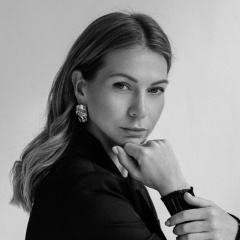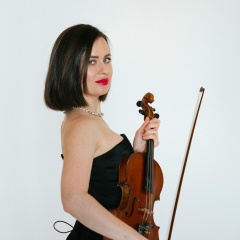Loretta Lux,
vk.com/album-26953_9956925
"Фотографировать Люкс начала в 1999 году, и в том, что касается темпа работы, она сродни скорее живописцу: в год она создает около шести законченных произведений. Ее портреты детей (хотя порой она выбирает в качестве моделей взрослых и иногда себя) очень тщательно продумываются на каждой из стадий их создания: начиная с поз, которые она выбирает для снимка, и заканчивая мягкой цветовой гаммой пастельных тонов, присущей окончательным отпечаткам. Часто в качестве моделей она использует детей своих друзей, вдумчиво подбирая костюмы для каждого из них (иногда это уже ставшая винтажной одежда, часто — вещи самой Лоретты) и продумывая все компьютерные эффекты. Удлиненные конечности, увеличенные головы, глаза, расположенные чуть дальше друг от друга, чем это обычно бывает, — все это, вкупе с фоном и пристальным взглядом детских глаз, создает ощущение некоей таинственности и необычности. Компьютер Люкс также использует, чтобы совместить своих персонажей с фоном будущего снимка, для создания которого она использует собственные фотографии различных европейских пейзажей и домов, а иногда рисует задник сама. Когда работа над снимком завершена, Лоретта делает ильфохромные отпечатки, которые, будучи сделанными на пластиковой основе, сохраняют ясность красок и глянцевитость.
Ее дебют состоялся в нью-йоркской галерее Yossi Milo в 2004 году. Эта выставка принесла необычайный успех и Люкс, и Yossi Milo: работы были распроданы по небывалым для молодой галереи ценам.
В работе над произведением Люкс сочетает фотографию, живопись и цифровую обработку. Эстетика и исполнение ее работ, одновременно притягательных и тревожных, имеет множество источников. Ведь изначально Лоретта Люкс обучалась живописи в Мюнхенской академии искусств, и основополагающее влияние на нее оказало творчество Диего Веласкеса, Аньоло ди Козимо и Филиппа Отто Рунге. Кроме того, ее художественное сознание уходит корнями в викторианскую эпоху, когда творили знаменитые создатели детских фотопортретов Джулия Маргарет Камерон и Льюис Кэрролл.
Увидев работы Лоретты Люкс в первый раз, зритель может принять их за живописные полотна. Дети, изображенные на них, будто бы вылеплены из гипса или фарфора: неподвижные, спокойные, хрупкие, овеянные фантастической, сверхъестественной аурой, они пристально вглядываются в зрителя. В них заключается и выражается вся загадочность и волшебство мира детей.
Процесс создания произведений довольно трудоемок. Лоретта объясняет своим юным моделям, какие позы они должны принимать, как им стоит вести себя. Своих героев Люкс помещает в утрированно идиллическое пространство. Эффект невероятной, сказочной атмосферы достигается уже после получения снимка с помощью компьютерной обработки.
Сама Лоретта Люкс утверждает, что ее портреты детей портретами в традиционном значении этого слова не являются: «Это фантазийные портреты, отсылающие нас к идее Детства. Детство всегда мыслилось как некий идеальный потерянный рай, в который нам больше не суждено вернуться. Мы изгнаны из этого мира беззаботности, невинности и единения. Однако вымышленные миры — это не более чем проекция идей и стремлений взрослых, это всего лишь выражение наших собственных желаний. Фотографируя детей в одиночестве, в отдалении от каких бы то ни было социальных норм и устоев, я позволяю им существовать самостоятельно… Я исследую неоднозначную и неясную связь между миром и человеческим „Я”».
В 2002 году Лоретте Люкс была вручена Баварская премия за развитие искусств, а в 2005 году Международный центр фотографии вручил ей награду Infinity Award в области искусств. С тех пор снимки Люкс часто выставляются за рубежом, например, в 2006 году — в Музее фотографии в Гааге и на Шестой московской фотобиеннале. Работы Люкс входят в собрания музеев Европы и США, среди них можно назвать нью-йоркский Музей Гуггенхайма, Музей современного искусства в Сан-Франциско, Музей актуального искусства Лос-Анджелеса, Лос-Анджелесский городской музей искусств, Институт искусств в Чикаго, Израильский музей в Иерусалиме, Музей фотографии в Гааге, мадридский Музей Королевы Софии, Елисейский музей в Лозанне, Национальный музей современного искусства в Токио, Австралийский центр фотографии в Сиднее. Многие журналы, посвященные художественной фотографии, публиковали подборки ее снимков".
vk.com/album-26953_9956925
"Фотографировать Люкс начала в 1999 году, и в том, что касается темпа работы, она сродни скорее живописцу: в год она создает около шести законченных произведений. Ее портреты детей (хотя порой она выбирает в качестве моделей взрослых и иногда себя) очень тщательно продумываются на каждой из стадий их создания: начиная с поз, которые она выбирает для снимка, и заканчивая мягкой цветовой гаммой пастельных тонов, присущей окончательным отпечаткам. Часто в качестве моделей она использует детей своих друзей, вдумчиво подбирая костюмы для каждого из них (иногда это уже ставшая винтажной одежда, часто — вещи самой Лоретты) и продумывая все компьютерные эффекты. Удлиненные конечности, увеличенные головы, глаза, расположенные чуть дальше друг от друга, чем это обычно бывает, — все это, вкупе с фоном и пристальным взглядом детских глаз, создает ощущение некоей таинственности и необычности. Компьютер Люкс также использует, чтобы совместить своих персонажей с фоном будущего снимка, для создания которого она использует собственные фотографии различных европейских пейзажей и домов, а иногда рисует задник сама. Когда работа над снимком завершена, Лоретта делает ильфохромные отпечатки, которые, будучи сделанными на пластиковой основе, сохраняют ясность красок и глянцевитость.
Ее дебют состоялся в нью-йоркской галерее Yossi Milo в 2004 году. Эта выставка принесла необычайный успех и Люкс, и Yossi Milo: работы были распроданы по небывалым для молодой галереи ценам.
В работе над произведением Люкс сочетает фотографию, живопись и цифровую обработку. Эстетика и исполнение ее работ, одновременно притягательных и тревожных, имеет множество источников. Ведь изначально Лоретта Люкс обучалась живописи в Мюнхенской академии искусств, и основополагающее влияние на нее оказало творчество Диего Веласкеса, Аньоло ди Козимо и Филиппа Отто Рунге. Кроме того, ее художественное сознание уходит корнями в викторианскую эпоху, когда творили знаменитые создатели детских фотопортретов Джулия Маргарет Камерон и Льюис Кэрролл.
Увидев работы Лоретты Люкс в первый раз, зритель может принять их за живописные полотна. Дети, изображенные на них, будто бы вылеплены из гипса или фарфора: неподвижные, спокойные, хрупкие, овеянные фантастической, сверхъестественной аурой, они пристально вглядываются в зрителя. В них заключается и выражается вся загадочность и волшебство мира детей.
Процесс создания произведений довольно трудоемок. Лоретта объясняет своим юным моделям, какие позы они должны принимать, как им стоит вести себя. Своих героев Люкс помещает в утрированно идиллическое пространство. Эффект невероятной, сказочной атмосферы достигается уже после получения снимка с помощью компьютерной обработки.
Сама Лоретта Люкс утверждает, что ее портреты детей портретами в традиционном значении этого слова не являются: «Это фантазийные портреты, отсылающие нас к идее Детства. Детство всегда мыслилось как некий идеальный потерянный рай, в который нам больше не суждено вернуться. Мы изгнаны из этого мира беззаботности, невинности и единения. Однако вымышленные миры — это не более чем проекция идей и стремлений взрослых, это всего лишь выражение наших собственных желаний. Фотографируя детей в одиночестве, в отдалении от каких бы то ни было социальных норм и устоев, я позволяю им существовать самостоятельно… Я исследую неоднозначную и неясную связь между миром и человеческим „Я”».
В 2002 году Лоретте Люкс была вручена Баварская премия за развитие искусств, а в 2005 году Международный центр фотографии вручил ей награду Infinity Award в области искусств. С тех пор снимки Люкс часто выставляются за рубежом, например, в 2006 году — в Музее фотографии в Гааге и на Шестой московской фотобиеннале. Работы Люкс входят в собрания музеев Европы и США, среди них можно назвать нью-йоркский Музей Гуггенхайма, Музей современного искусства в Сан-Франциско, Музей актуального искусства Лос-Анджелеса, Лос-Анджелесский городской музей искусств, Институт искусств в Чикаго, Израильский музей в Иерусалиме, Музей фотографии в Гааге, мадридский Музей Королевы Софии, Елисейский музей в Лозанне, Национальный музей современного искусства в Токио, Австралийский центр фотографии в Сиднее. Многие журналы, посвященные художественной фотографии, публиковали подборки ее снимков".
Loretta Lux,
vk.com/album-26953_9956925
“She started photographing Lux in 1999, and as far as the pace of work is concerned, she’s more like a painter: she creates about six finished works a year. Her portraits of children (although sometimes she chooses adults as models and sometimes herself) are carefully thought out at each stage of their creation: starting from the poses that she chooses to take the picture, and ending with the soft pastel colors inherent in the final prints.Often, she uses her friends' children as models, carefully choosing costumes for each of them (sometimes it’s already become vintage clothing, often things of Loretta herself) and thinking through all the computer effects: elongated limbs, enlarged heads, eyes located a little further apart than usual, all this, coupled with a background and close the look of children's eyes, creates a feeling of some mystery and unusualness.Computer Suite also uses to combine her characters with the background of the future picture, for the creation of which she uses her own photos of various European landscapes and houses, and sometimes draws a backdrop herself. When the work on the picture is completed, Loretta makes ilfochrome prints, which, being made on a plastic basis, preserve the clarity of colors and gloss.
Her debut took place in the New York gallery Yossi Milo in 2004. This exhibition brought extraordinary success to both Lux and Yossi Milo: the works were sold at unprecedented prices for the young gallery.
In his work on the piece, Luxe combines photography, painting and digital processing. Aesthetics and the execution of her work, both attractive and disturbing, has many sources. After all, initially Loretta Lux studied painting at the Munich Academy of Arts, and the fundamental influence on her was exerted by the work of Diego Velazquez, Agnolo di Cosimo and Philippe Otto Runge. In addition, her artistic consciousness rooted in the Victorian era, when the famous creators of children's photographs Julia Margaret Cameron and Lewis Carroll created.
After seeing the works of Loretta Lux for the first time, the viewer can take them for paintings. The children depicted on them, as if molded from plaster or porcelain: motionless, calm, fragile, fanned by a fantastic, supernatural aura, they gaze intently at the viewer. They contain and express all the mystery and magic of the world of children.
The process of creating works is rather laborious. Loretta explains to her young models what poses they should take, how they should behave. Lux places his heroes in an exaggerated idyllic space. The effect of an incredible, fabulous atmosphere is achieved after the picture is taken using computer processing.
Loretta Lux herself claims that her portraits of children are not portraits in the traditional sense of the word: “These are fantasy portraits that refer us to the idea of Childhood. Childhood has always been thought of as some ideal lost paradise, into which we are no longer destined to return. We are expelled from this world of carelessness, innocence and unity. However, fictional worlds are nothing more than a projection of the ideas and aspirations of adults, it is just an expression of our own desires. By photographing children alone, away from any social norms and principles, I allow them to exist independently ... I will explore the ambiguous and unclear connection between the world and the human “I”. ”
In 2002, the Loretta Luxe was awarded the Bavarian Prize for the Development of the Arts, and in 2005 the International Center for Photography awarded her the Infinity Award in the field of art. Since then, Luxe’s photos have often been exhibited abroad, for example, in 2006, at the Museum of Photography in The Hague and at the Sixth Moscow Photobiennale. Lux's works are included in the collections of museums in Europe and the USA, among them the New York Guggenheim Museum, the Museum of Contemporary Art in San Francisco, the Museum of Contemporary Art of Los Angeles, the Los Angeles City Museum of Art, the Institute of Art in Chicago, the Israeli Museum in Jerusalem, The Hague Museum of Photography, Queen Sophia Museum of Madrid, Elysee Museum of Lausanne, Tokyo National Museum of Modern Art, Australian Center for Photography in Sydney. Many magazines dedicated to art photography have published collections of her photographs. "
vk.com/album-26953_9956925
“She started photographing Lux in 1999, and as far as the pace of work is concerned, she’s more like a painter: she creates about six finished works a year. Her portraits of children (although sometimes she chooses adults as models and sometimes herself) are carefully thought out at each stage of their creation: starting from the poses that she chooses to take the picture, and ending with the soft pastel colors inherent in the final prints.Often, she uses her friends' children as models, carefully choosing costumes for each of them (sometimes it’s already become vintage clothing, often things of Loretta herself) and thinking through all the computer effects: elongated limbs, enlarged heads, eyes located a little further apart than usual, all this, coupled with a background and close the look of children's eyes, creates a feeling of some mystery and unusualness.Computer Suite also uses to combine her characters with the background of the future picture, for the creation of which she uses her own photos of various European landscapes and houses, and sometimes draws a backdrop herself. When the work on the picture is completed, Loretta makes ilfochrome prints, which, being made on a plastic basis, preserve the clarity of colors and gloss.
Her debut took place in the New York gallery Yossi Milo in 2004. This exhibition brought extraordinary success to both Lux and Yossi Milo: the works were sold at unprecedented prices for the young gallery.
In his work on the piece, Luxe combines photography, painting and digital processing. Aesthetics and the execution of her work, both attractive and disturbing, has many sources. After all, initially Loretta Lux studied painting at the Munich Academy of Arts, and the fundamental influence on her was exerted by the work of Diego Velazquez, Agnolo di Cosimo and Philippe Otto Runge. In addition, her artistic consciousness rooted in the Victorian era, when the famous creators of children's photographs Julia Margaret Cameron and Lewis Carroll created.
After seeing the works of Loretta Lux for the first time, the viewer can take them for paintings. The children depicted on them, as if molded from plaster or porcelain: motionless, calm, fragile, fanned by a fantastic, supernatural aura, they gaze intently at the viewer. They contain and express all the mystery and magic of the world of children.
The process of creating works is rather laborious. Loretta explains to her young models what poses they should take, how they should behave. Lux places his heroes in an exaggerated idyllic space. The effect of an incredible, fabulous atmosphere is achieved after the picture is taken using computer processing.
Loretta Lux herself claims that her portraits of children are not portraits in the traditional sense of the word: “These are fantasy portraits that refer us to the idea of Childhood. Childhood has always been thought of as some ideal lost paradise, into which we are no longer destined to return. We are expelled from this world of carelessness, innocence and unity. However, fictional worlds are nothing more than a projection of the ideas and aspirations of adults, it is just an expression of our own desires. By photographing children alone, away from any social norms and principles, I allow them to exist independently ... I will explore the ambiguous and unclear connection between the world and the human “I”. ”
In 2002, the Loretta Luxe was awarded the Bavarian Prize for the Development of the Arts, and in 2005 the International Center for Photography awarded her the Infinity Award in the field of art. Since then, Luxe’s photos have often been exhibited abroad, for example, in 2006, at the Museum of Photography in The Hague and at the Sixth Moscow Photobiennale. Lux's works are included in the collections of museums in Europe and the USA, among them the New York Guggenheim Museum, the Museum of Contemporary Art in San Francisco, the Museum of Contemporary Art of Los Angeles, the Los Angeles City Museum of Art, the Institute of Art in Chicago, the Israeli Museum in Jerusalem, The Hague Museum of Photography, Queen Sophia Museum of Madrid, Elysee Museum of Lausanne, Tokyo National Museum of Modern Art, Australian Center for Photography in Sydney. Many magazines dedicated to art photography have published collections of her photographs. "
У записи 4 лайков,
0 репостов.
0 репостов.
Эту запись оставил(а) на своей стене Сергей Шершнев























